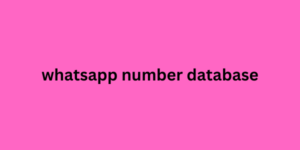In fact, to keep up with demand, the Bureau of Labor Statistics predicts that the personal trainer industry will grow by 15% from 2019 to 2029, adding 57,600 more trainers in a decade.
Where do most people find personal trainers? whatsapp number database Online, of course. So if you’re a personal trainer, or working for a fitness company, your website needs to be top-notch.

We’ve compiled this list of 10 amazing personal training websites along with key lessons you can apply to your own site.
Listen to the audio version of this post:
Editor’s note: Are you a personal trainer looking to build your first website? Then, you’ll want to check out the GetResponse AI Website Builder. It comes with website templates, an intuitive user interface, and even an AI-creator that’ll build a custom website tailored to your needs. Just answer a few simple questions, choose a design style, and you’ve got at least three personalized templates to choose from.
BUILD YOUR WEBSITE WITH AI
You can watch it in action here:
Here are 10 of the best personal trainer websites we’ve seen:
There are lots of different ways to showcase your skills as a personal trainer and attract customers. Check out these ten sites to find some inspiration.
1. Girls Gone Strong
Personal training website example - Girls Gone Strong.
Girls Gone Strong is a personal training website dedicated to women’s health, strength, and empowerment. As you can see above, their website does a great job of identifying with women right off the bat using both imagery and website’s header.
Then the website tells you exactly what they do (women-specific health and fitness coaching and certifications), followed by some serious social proof (recommended by Yale, Johns Hopkins, Time, ABC, Today, Women’s Health, and more). Thanks to these, website visitors know exactly that they’re in the right place and that they can trust this brand.
After that, the GSS website offers users a clear path to finding information specific to their goals with three call-to-action (CTA) buttons. Thanks to these descriptive CTAs, clients can select the offer that matches the stage on their fitness journey.
Descriptive call to action buttons on GGS website.
As you keep scrolling further, you see articles and a newsletter signup form aimed at those that’d like to follow the brand, and maybe not necessarily sign up for their services just yet. By offering these, GSS can start building relationships with their audience (even after visitors leave the website) and show off their expertise, which will help to bring them more clients in the long run.
Newsletter form on the Girls Gone Strong online personal training website.
At the bottom of this website, you’ll also find various kinds of free courses. These lead magnets, as we call them, are great for attracting new clients who may feel hesitant to sign up for the full program. By offering them a free resource, personal trainer gathers their potential client’s contact details and can upsell them with their paid program via email later.
Free resources on the Girls Gone Strong online personal training website.
Key lessons from the Girls Gone Strong website:
Use visuals that are relatable to your target market. For example, GSS focuses on serving women, so they used an image of a strong woman in their hero header.
Feature social proof prominently on your website — 63% of consumers say they’re more likely to purchase from a website with reviews. If you have well-known clients, you can just use their name or logo. If you work with individuals, you can use testimonials.
If you offer multiple services, make it easy for users to navigate quickly to what they need.
Provide a newsletter signup form to build long-term relationships with your audience and eventually turn them into customers.
Offer free resources to obtain your potential customer’s details and upsell them with your paid services via email later.
